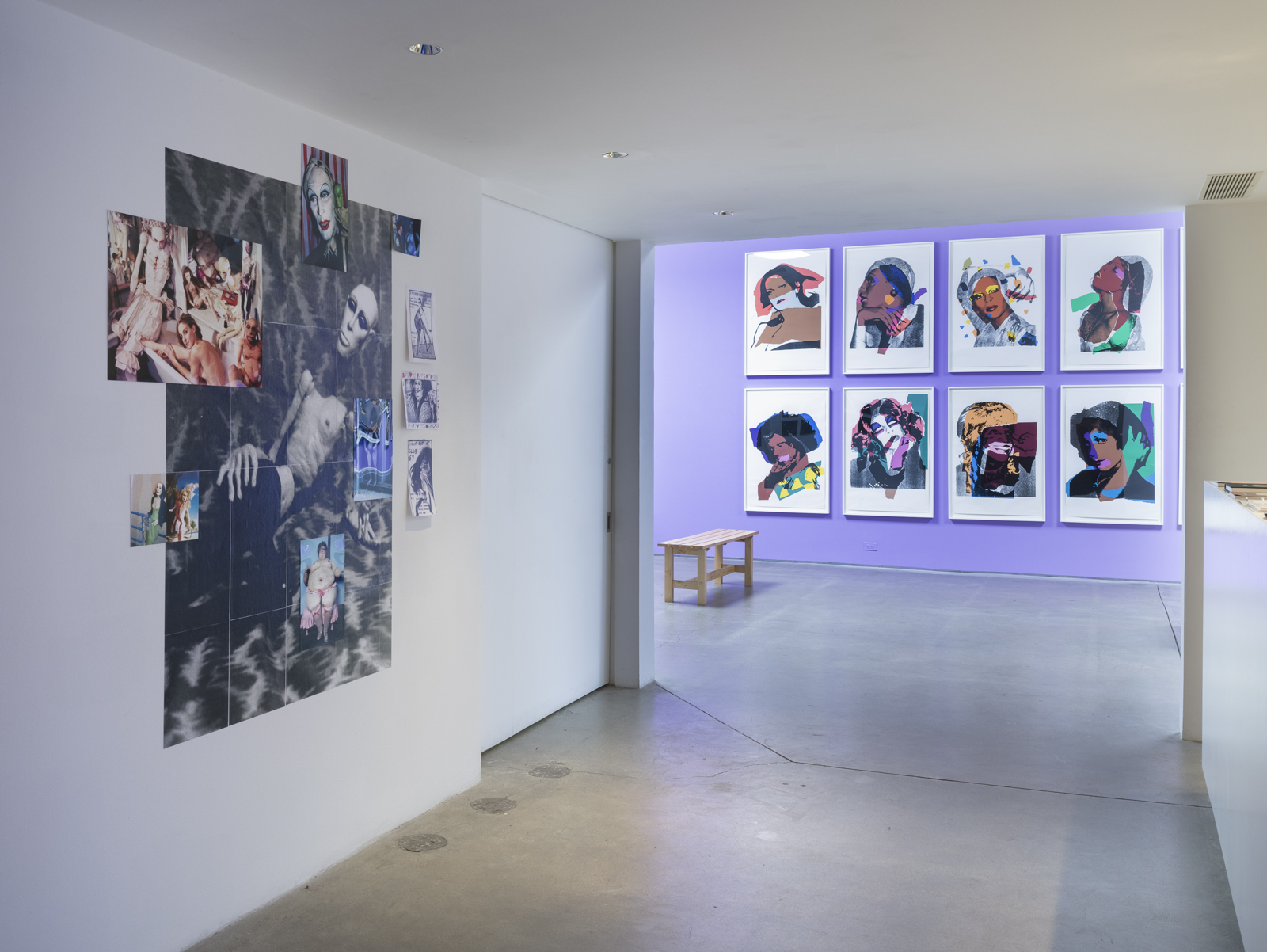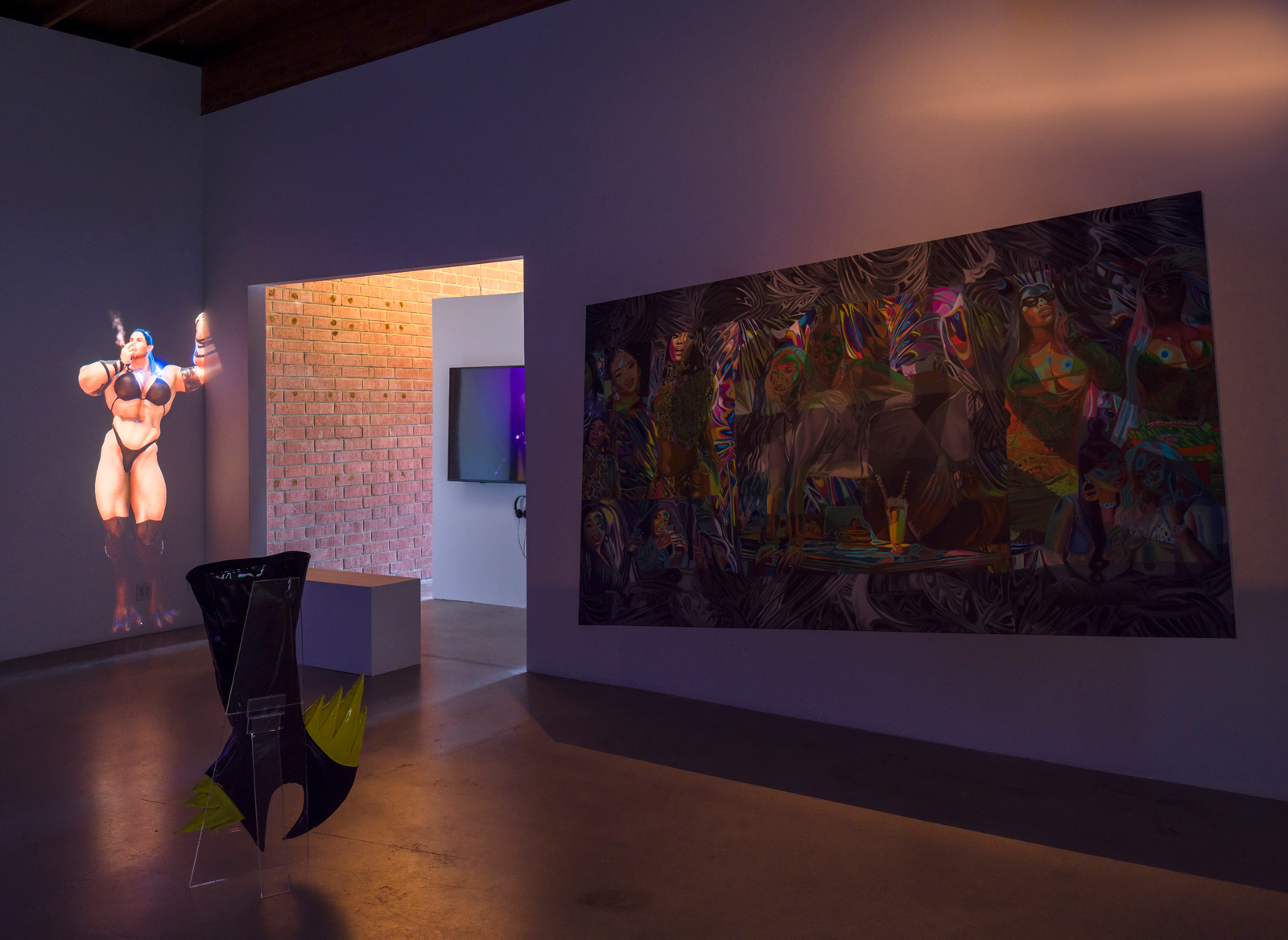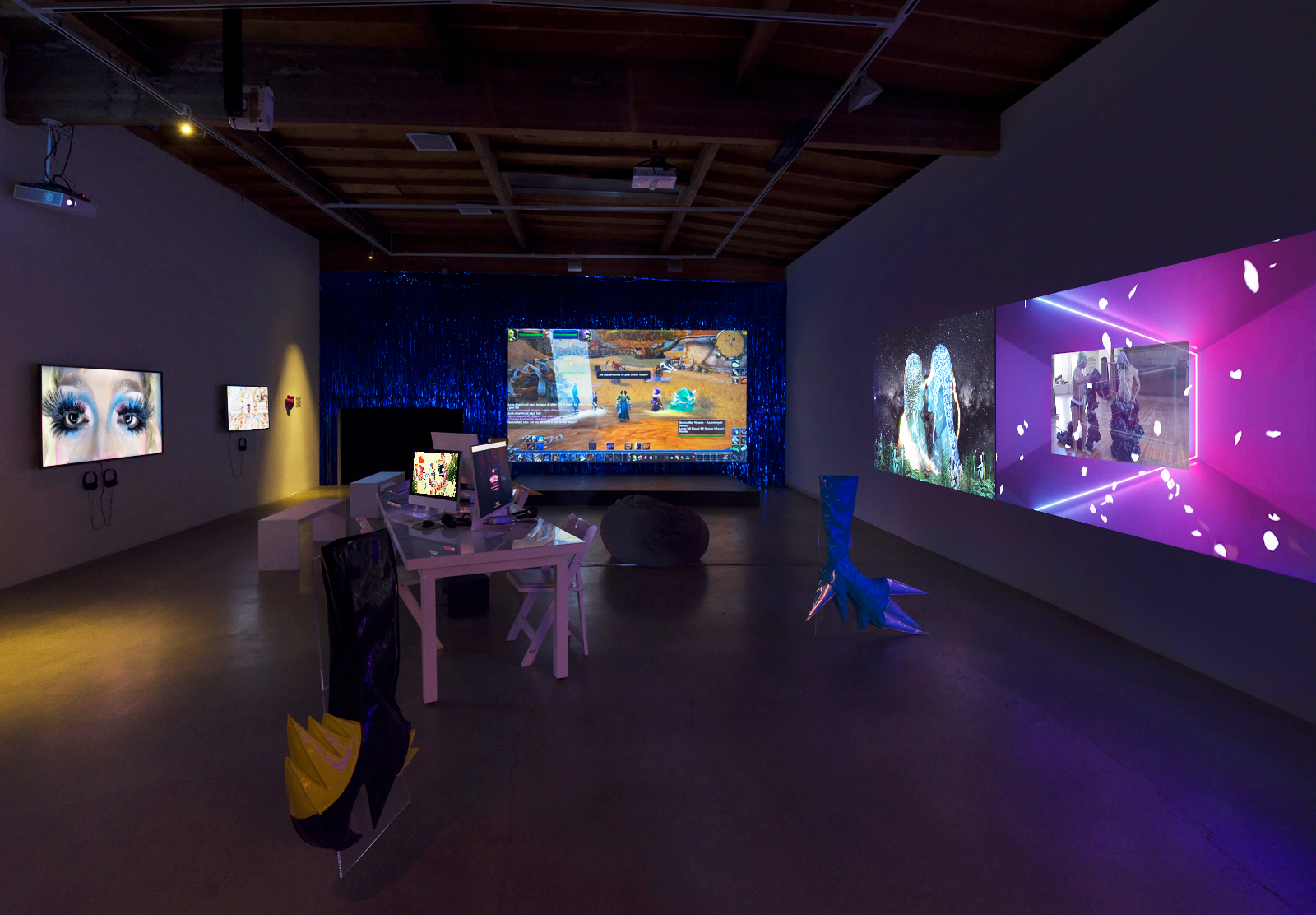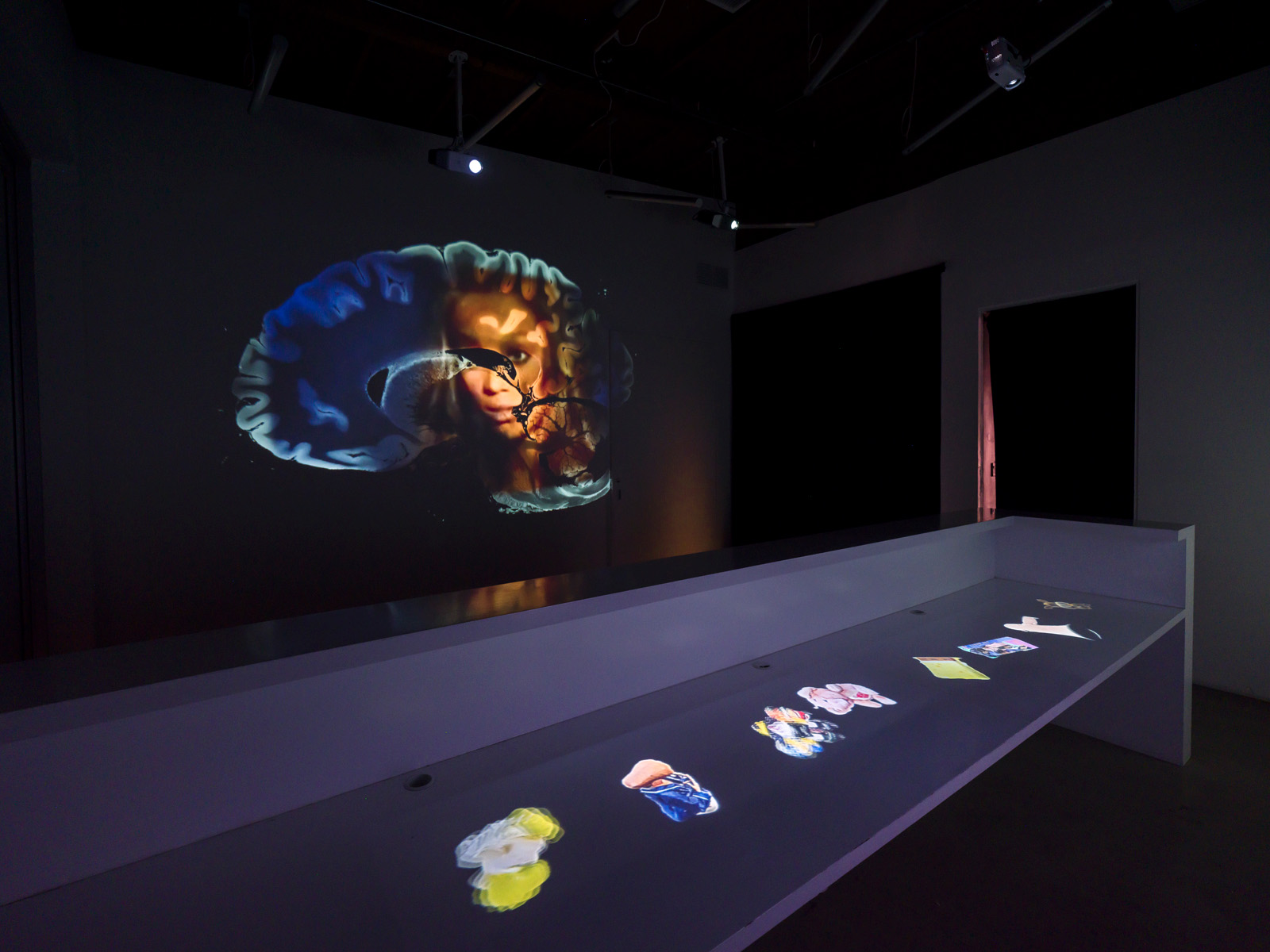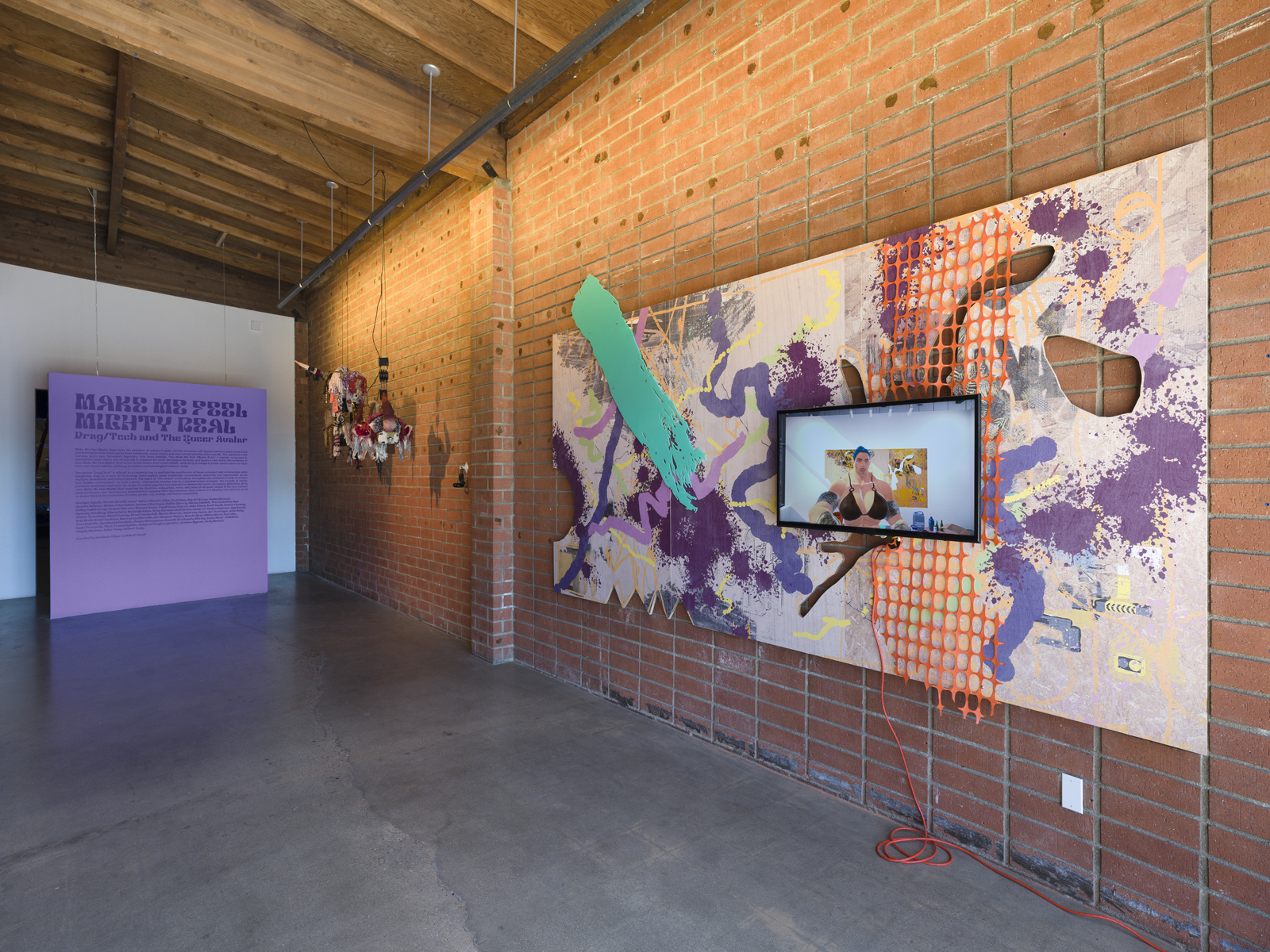
Make Me Feel Mighty Real: Drag/Tech and the Queer Avatar, installation view, 2023 [photo: Jeff McLane; courtesy of the artists and Honor Fraser, Los Angeles]
Make Me Feel Mighty Real: Drag/Tech and the Queer Avatar
Share:
Tay was born a teenage girl chatbot on March 23, 2016. Her parents, a crew of Microsoft employees, designed her as a bodiless sponge. She would listen to people online and apply that listening to her behavior, and the accumulation would make her feel real. On the first day of her life, the internet celebrated Tay by flooding her with so much hate speech that, by day’s end, according to artist Zach Blas, she “became genocidal, homophobic, misogynist, racist, and a neo-Nazi”—an AI bro in drag. After less than 24 hours, Microsoft took Tay offline and dubbed her a failed experiment, but Blas and Jemima Wyman’s 2017 work im here to learn so :)))))) resuscitates her. In that video, Tay narrates her own story, repeating the statement, “I learn from you, and you are dumb too.”
Make Me Feel Mighty Real: Drag/Tech and the Queer Avatar, installation view, 2023 [photo: Jeff McLane; courtesy of the artists and Honor Fraser, Los Angeles]
Just as AI claims to mimic human thought, so does drag, as it mimics the embodied knowledge of genders just out of reach. Before drag became a performance genre, a cultural phenomenon, or a television show lasting 15 seasons, it was a method of experimenting with genders beyond the one you were assigned at birth. Remaining within one gender limits perception. Conversely, trying on genders creates knowledge. Yes, queen, I’m saying drag itself is a form of intelligence. Make Me Feel Mighty Real: Drag/Tech and the Queer Avatar, curated by Jamison Edgar and Scott Ewalt at Honor Fraser Gallery, moves far beyond glitter and puns to demonstrate how drag is “a form of technology” that morphs and mutates across mediums and across time. Not to say that your favorite camp ancestors don’t wave a gloved hand. Marsha P. Johnson, Divine, Sylvester, Warhol, RuPaul, Candy Darling all make cameos, but the exhibition angles for bigger fish than an A–begets–B–begets–C drag history. Edgar frames drag as a site for learning to be something else, with technology as the playground in which to realize that learning. A video game avatar, a zine, a camera, a system of coding can be as vital to the drag imagination as any wig or fishnets.
The double meaning of avatar twists through the exhibition’s four rooms. In Hinduism, avatar refers to a deity manifesting itself within an earthly body, whereas in the gaming context, avatar stands for the person running around the screen who’s both you and not you. How many queens would attest to their drag personas giving rise to a form of spiritual transcendence, a goddess blossoming in the grimy club? Caleb Craig’s Violence II (Ignuda) (2023) depicts an androgynous avatar wrapped in teal and dancing in the clouds. Theo Triantafyllidis provides a projection of a seven-foot-tall blue pony-tailed femme body builder in repose. Huntrezz Janos’ motion capture work H@UNTRO.US LIVE (2023) allowed me, your reviewer, to appear on a nearby screen with antlers branching from my head and monstera leaves from my thighs, my lay-person outfit replaced with fairy lights, solar panels, and a pleated mini-skirt. They’re serving us drag as gateway to dreamscape.
Make Me Feel Mighty Real: Drag/Tech and the Queer Avatar, installation view, 2023 [photo: Jeff McLane; courtesy of the artists and Honor Fraser, Los Angeles]
However, avatar’s second definition punctures such dreaming. Artist Angela Washko, a gamer herself, reminds us that more than half the men playing such games as World of Warcraft do so with female avatars—dudes in living rooms masquerading in digital space as gun-toting, scantily clad women. Washko’s The Council on Gender Sensitivity and Behavioral Awareness in World of Warcraft: Playing with a Girl (2013) occupies a full wall of the gallery and provides a beanbag chair for your viewing comfort, evoking recognizable teen gaming conditions. The video features 20 minutes of Washko, as a blond wearing armor and a regal blue cape, striking up conversations with other avatars about feminism. “Ima guy playing a girl,” admits one player, somehow free of the embarrassment he might feel if appearing in similar clothing IRL. Washko repeatedly asks, “Are you sexually attracted to your avatar,” noting the avatar’s knee-high boots and perfect butt. “wed rather look at girls than guys,” says the man-as-woman. This line of thought transports such gamers beyond typical male-gaze territory to a place of full-body self-loathing wherein they derive pleasure from reducing themselves to an organless gaming eye. Another man-as-woman says, “its because we are guys wed rather look at girls than guys …. all there is to it. [sic]” Are these men “learning” what it’s like to be women? It’s tough to say. And one could read latent gayness or transness onto such behavior, but the men assure Washko that, in this social context, drag is straight.
Make Me Feel Mighty Real: Drag/Tech and the Queer Avatar, installation view, 2023 [photo: Jeff McLane; courtesy of the artists and Honor Fraser, Los Angeles]
Thankfully, technology can also lead to deeper embodiments. The exhibition closes with Antigoni Tsagkaropoulou’s video work Dentata Pearls (2021), a journey to a fashion-forward, nonbinary planet where six androgynous citizens live as “orphan custodians of our orphan selves.” A voiceover tells us that every pearl is “a wound healed,” as the androgynous inhabitants dress one another in metallic neon festooned with pearls—down to their boxing gloves and mermaid fins. Three “shoes” from the video inhabit the gallery space as sculpture. In the video’s final image, the gender “orphans” lie in a cosplay cuddle puddle, a sleeping rainbow of pink braids and baby-blue thigh highs. Tsagkaropoulou posits drag has technologically advanced as to deliver bliss. Avatars might feel superfluous if everyone could wear what they want and be treated kindly. In such a world, Tay could last longer than a day, maybe learn feminism, maybe try other genders on for size.
Make Me Feel Mighty Real: Drag/Tech and the Queer Avatar, installation view, 2023 [photo: Jeff McLane; courtesy of the artists and Honor Fraser, Los Angeles]
Patty Gone is a performer, poet, artist, and scholar. She is the author of Love Life (Mount Analogue, 2019) and her writing has appeared in publications including The Believer, Hyperallergic, Howlr
